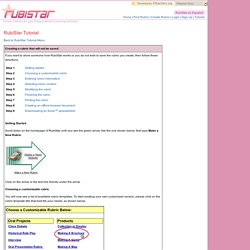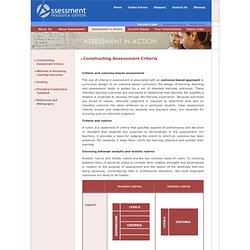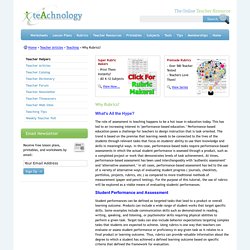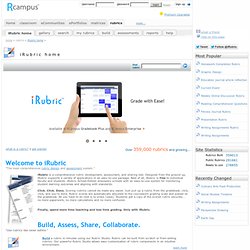

Rubistar Tutorial. Creating a Rubric that will not be saved. If you want to show someone how RubiStar works or you do not wish to save the rubric you create, then follow these directions.

Getting Started Scroll down on the homepage of RubiStar until you see the green arrow, like the one shown below, that says Make a New Rubric. Click on the arrow or the text link directly under the arrow. Choosing a customizable rubric You will now see a list of available rubric templates. Entering rubric information Next you will begin entering your information into the rubric. Now add your zip code. Selecting rubric content The rating scale for the rubric is set to automatically display a numerical rating scale (4, 3, 2, 1). Next you will be able to select your rubric categories. Repeat the previous step for all of the categories you wish to include in your rubric. You can edit the text by clicking in the boxes. If at any time you would like to erase all the changes you made to one box, click the Reset button as shown in the image below. Rubrics. Rubrics Descriptors Why Include Levels of Performance?

Analytic Versus Holistic Rubrics How Many Levels of Performance Should I Include in my Rubric? Rubric: A scoring scale used to assess student performance along a task-specific set of criteria Authentic assessments typically are criterion-referenced measures. That is, a student's aptitude on a task is determined by matching the student's performance against a set of criteria to determine the degree to which the student's performance meets the criteria for the task.
Research Rubric As in the above example, a rubric is comprised of two components: criteria and levels of performance. For each criterion, the evaluator applying the rubric can determine to what degree the student has met the criterion, i.e., the level of performance. Finally, the rubric above contains a mechanism for assigning a score to each project. The above rubric includes another common, but not a necessary, component of rubrics -- descriptors. Thus, start small. Or. Assessment Resource Centre. Criteria and outcome-based assessment The use of criteria in assessment is associated with an outcome-based approach to curriculum design.

In an outcome-based curriculum, the design of learning, teaching and assessment tasks is guided by a set of intended learning outcomes. These intended learning outcomes are expressed in statements that describe the qualities a student is expected to develop through the learning experience. Because outcomes are broad in nature, informed judgment is required to determine how well an intended outcome has been achieved by a particular student. Clear assessment criteria, known and understood by students and teachers alike, are essential for ensuring such an informed judgment. Criteria and rubrics. Why Rubrics? Super Rubric Makers - Print Them Instantly!

- All K-12 Subjects View Now... Premade Rubrics - Over 500 Teacher Tested - Teachers Love Them! View Series Why Rubrics? What's All the Hype? The role of assessment in teaching happens to be a hot issue in education today. Student Performance and Assessment Student performances can be defined as targeted tasks that lead to a product or overall learning outcome. What are Rubrics? Rubrics are performance-based assessments that evaluate student performance on any given task or set of tasks that ultimately leads to a final product, or learning outcome.
Rating scales can be either holistic or analytical. Holistic scoring is more global and does little to separate the tasks in any given product, but rather views the final product as a set of interrelated tasks contributing to the whole. Analytic scoring breaks down the objective or final product into component parts and each part is scored independently. An example of a holistic scale is as follows: RubiStar Home. Rubric Guidelines. iRubric: Home of free rubric tools: RCampus. Welcome to iRubric iRubric is a comprehensive rubric development, assessment, and sharing tool.

Designed from the ground up, iRubric supports a variety of applications in an easy-to-use package. Best of all, iRubric is free to individual faculty and students. iRubric School-Edition empowers schools with an easy-to-use system for monitoring student learning outcomes and aligning with standards. Click. Click. Finally, spend more time teaching and less time grading. Build, Assess, Share, Collaborate. "Use rubrics like never before. " It's Free. I just click on the box under each one of these,... and it does all the math for me. "Free? Individual educators and students can use iRubric and a hundreds of other free RCampus features at no charge.
iRubric Enterprise Edition "Monitor student learning outcomes the efficient way. " The iRubric Enterprise Edition empowers schools to take their assessments monitoring to the next level. We provide flexible licensing and hosting plans that meet your needs. Designing scoring rubrics for your classroom. Mertler, Craig A.